Viele Blogger beginnen ihre Reise mit Blogger, weil es eine kostenlose und unkomplizierte Plattform ist. Wenn Ihr Blog jedoch wächst, könnten Sie sich durch die begrenzten Funktionen eingeschränkt fühlen.
Die Umstellung auf WordPress kann mit seinen umfangreichen Berechtigungen eine Welt der Möglichkeiten eröffnen. Aber es gibt eine häufige Sorge bei diesem Wechsel: der mögliche Verlust von Google-Rankings.
Dieser Artikel wird Sie durch den Übergang von Blogger zu WordPress führen. Wir werden uns darauf konzentrieren, wie Sie es richtig machen und sicherstellen, dass Sie Ihre wertvollen Google-Rankings intakt halten.
Unser Ziel ist es, Ihnen beim Upgrade Ihrer Blogging-Plattform zu helfen, ohne die SEO-Bemühungen zu opfern, die Sie bereits in Ihre Website gesteckt haben.
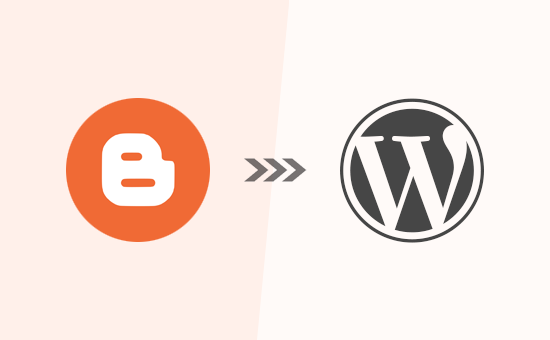
Warum von Blogger zu WordPress wechseln?
Blogger ist eine beliebte Blogging-Plattform, die von Google entwickelt wurde. Hier kann jeder mit seinem Google-Konto ein kostenloses Blog erstellen.
Viele Anfänger stellen jedoch schnell fest, dass sie mit ihrem kostenlosen Blogger-Blog nur sehr eingeschränkt arbeiten können.
Mit WordPress hingegen haben Sie die volle Kontrolle über Ihre Website. Außerdem können Sie die notwendigen Funktionen hinzufügen, um Ihren Blog zu erweitern und Ihre Inhalte zu vermarkten. Außerdem können Sie alle SEO-Optimierungen durchführen, um eine bessere Platzierung zu erreichen. Wir haben eine detaillierte Gegenüberstellung von WordPress und Blogger erstellt.
Wenn wir von WordPress sprechen, meinen wir das selbst gehostete WordPress.org, das NICHT mit WordPress.com verwechselt werden sollte, einer gehosteten Lösung, die ihre eigenen Einschränkungen hat. Einzelheiten finden Sie in unserem Artikel über den Unterschied zwischen WordPress.com und WordPress.org.
WordPress.org ist die beliebte „WordPress“-Plattform, von der Sie wahrscheinlich schon gehört haben, weil sie 43 % aller Websites im Internet betreibt.
Schauen wir uns also an, wie man richtig von Blogger zu WordPress wechselt und dabei die Google-Suchergebnisse und den Website-Traffic beibehält.
Hier sind die Schritte, die wir verwenden werden, um von Blogger zu WordPress zu übertragen:
Sind Sie bereit? Dann fangen wir an.
Video-Anleitung
Wenn Sie sich das Video-Tutorial nicht ansehen möchten, können Sie die Textversion weiter unten lesen.
Schritt 1: Registrieren Sie sich für WordPress Hosts
Um mit WordPress zu beginnen, benötigen Sie einen Domainnamen und ein Webhosting.
Zur Erinnerung: Ein Domain-Name ist die Adresse Ihrer Website, die man eintippt, um zu Ihrem Blog zu gelangen, und das Webhosting ist der Ort, an dem die Dateien Ihrer Website gespeichert sind. Beides ist ein MUSS für jede Art von Blog oder Website.
Wir empfehlen daher Bluehost. Bluehost ist eines der größten Hosting-Unternehmen der Welt und ein offiziell empfohlener WordPress-Hosting-Partner.
Da WPBeginner die größte Website für WordPress Ressourcen ist, haben sie zugestimmt, unseren Besuchern einen kostenlosen Domainnamen und einen 60%igen Rabatt auf das Hosting anzubieten. Im Grunde können Sie für nur 1,99 $ pro Monat loslegen.
Wenn Sie aus irgendeinem Grund eine Bluehost-Alternative bevorzugen, dann empfehlen wir Ihnen entweder SiteGround oder Hostinger, da beide ausgezeichnete Lösungen sind.
Sobald Sie sich für das WordPress-Hostingpaket angemeldet und Ihren Domainnamen eingerichtet haben, können Sie mit der WordPress-Installation fortfahren.
Wenn Sie sich bei Bluehost über unseren obigen Link anmelden, wird WordPress automatisch für Sie installiert.
Wenn Sie einen anderen WordPress-Hosting-Anbieter verwendet haben, müssen Sie WordPress installieren, indem Sie unsere ultimative Anleitung zur Installation von WordPress befolgen.
Nachdem Sie WordPress installiert haben, ist es an der Zeit, Ihre Inhalte von Blogger zu WordPress zu übertragen.
Kostenloses Bonusangebot: Da viele von Ihnen danach gefragt haben, bieten wir jetzt einen kostenlosen Migrationsdienst von Blogger zu WordPress als Teil unseres kostenlosen WordPress-Blog-Einrichtungsdienstes an. Das bedeutet, dass eines unserer fachkundigen Teammitglieder die gesamte Migration für Sie durchführt (100% kostenlos). Ja, Sie können buchstäblich ohne jedes Risiko von Blogger zu WordPress wechseln.
Hinweis: Unser kostenloser Blogger-Migrationsdienst ist für kleinere Blogs mit weniger als 1000 Blogbeiträgen gedacht. Wir können einen Migrationsdienst für größere Blogger-Websites anbieten, aber das ist ein kostenpflichtiger Dienst.
Wenn Sie jedoch jemand sind, der gerne lernt und Dinge selbst macht, dann können Sie unserer Schritt-für-Schritt-Anleitung unten folgen.
Schritt 1: Exportieren Sie Ihr Blogger-Blog
Als Erstes müssen Sie den Inhalt Ihres Blogger-Blogs exportieren.
Sie können dies tun, indem Sie die Blogger-Website besuchen und sich bei Ihrem Konto-Dashboard anmelden.
Gehen Sie dann zur Seite Einstellungen. Scrollen Sie nach unten zum Abschnitt „Blog verwalten“ und klicken Sie auf die Schaltfläche „Inhalt sichern“.
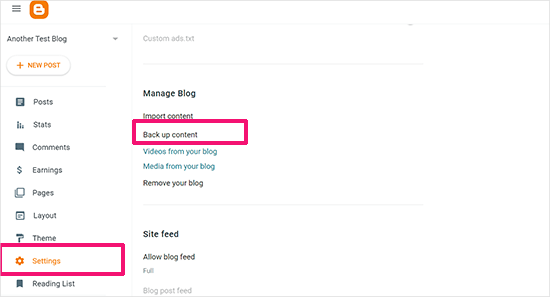
Daraufhin erscheint ein Popup-Fenster, in dem angezeigt wird, was genau in der Blogger-Sicherung enthalten ist.
Um fortzufahren, müssen Sie auf die Schaltfläche „Herunterladen“ klicken.
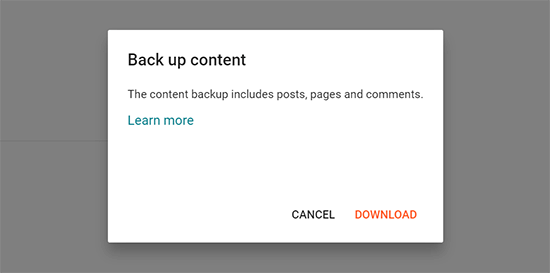
Der Inhalt Ihres Blogger-Blogs wird in einer XML-Datei auf Ihren Computer heruntergeladen.
Sobald der Download abgeschlossen ist, können Sie Ihre Blogger-Inhalte in Ihre WordPress-Website importieren.
Schritt 2: Blogger in WordPress importieren
Um mit dem Import Ihrer Blogger-Site in WordPress zu beginnen, melden Sie sich in Ihrem WordPress-Administrationsbereich an und besuchen Sie Tools “ Importieren.
Klicken Sie auf der Import-Seite auf den Link „Jetzt installieren“ unter Blogger.
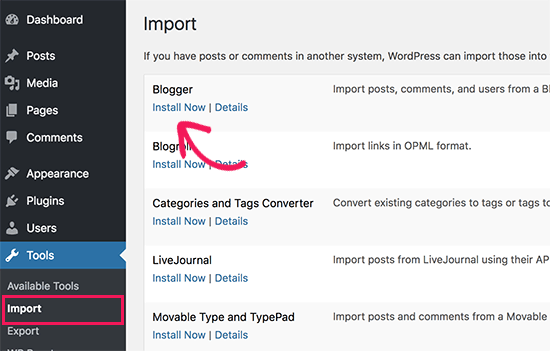
WordPress wird nun das Blogger-Importer-Plugin für Sie herunterladen und installieren.
Sobald die Installation abgeschlossen ist, müssen Sie auf den Link „Importer ausführen“ klicken, um fortzufahren.
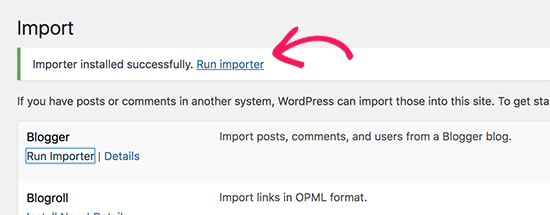
WordPress wird Sie auf dem Bildschirm Blogger importieren auffordern, die XML-Datei hochzuladen. Dies ist die Datei, die Sie in Schritt 1 heruntergeladen haben.
Klicken Sie einfach auf die Schaltfläche „Datei auswählen“ und laden Sie die XML-Datei hoch, die Sie zuvor heruntergeladen haben.
Klicken Sie anschließend auf die Schaltfläche „Datei hochladen und importieren“, um fortzufahren.
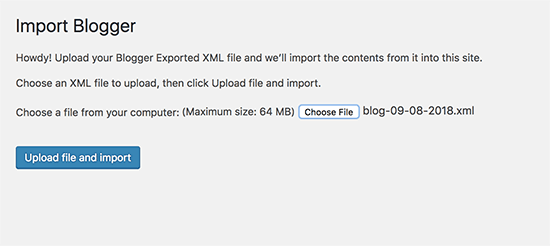
WordPress wird nun die Importdatei hochladen. Wenn Ihre Importdatei zu groß ist, wird möglicherweise eine Fehlermeldung angezeigt.
In diesem Fall müssen Sie die Höchstgrenze für den Datei-Upload erhöhen. Wenn Ihre Datei klein ist, werden Sie keine Fehler sehen.
Als Nächstes werden Sie aufgefordert, Beiträge einem Autor zuzuweisen. Wenn Sie mehrere Autoren in Ihrem Blogger-Blog haben, können Sie für jeden Autor ein neues Benutzerkonto erstellen. Sie können diese Beiträge auch bestehenden Autoren auf Ihrer WordPress-Website zuweisen.
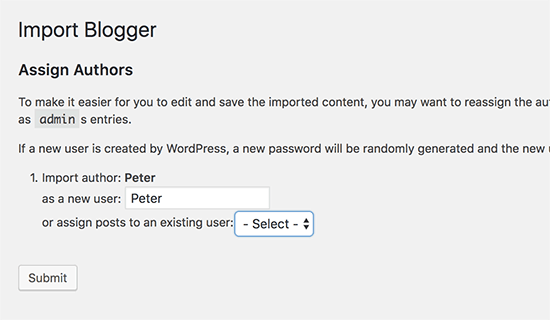
Nachdem Sie Ihre Auswahl getroffen haben, klicken Sie auf die Schaltfläche „Senden“, um fortzufahren.
WordPress importiert alle Inhalte aus der Blogger-Exportdatei in Ihre WordPress-Website. Sie können den Inhalt auf der Seite Beiträge “ Alle Beiträge einsehen.
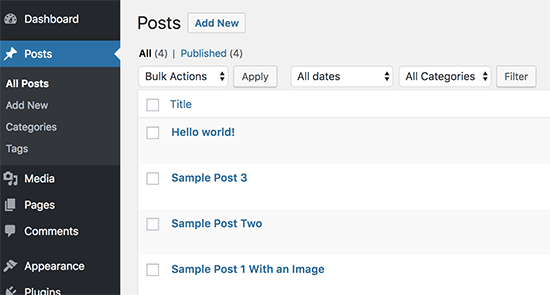
Schritt 3: Permalinks einrichten
Permalinks ist der Begriff für die URL-Struktur der einzelnen Seiten. WordPress verfügt über eine Funktion, mit der Sie eine SEO-freundliche URL-Struktur einrichten können.
Da Sie Inhalte von Blogger importieren, muss Ihre URL-Struktur der URL-Struktur Ihrer alten Blogger-Site so nahe wie möglich kommen.
Um Permalinks zu setzen, müssen Sie in Ihrem WordPress-Dashboard zu Einstellungen “ Permalinks gehen und die Option „Benutzerdefinierte Struktur“ wählen.
Danach müssen Sie den folgenden Text in das Feld neben dem Feld für die benutzerdefinierte Struktur eingeben:
/%year%/%monthnum%/%postname%.html

Mit dieser Permalink-Struktur ähneln die URLs Ihrer Blogposts den URLs in Ihrem alten Blogger-Blog.
Es kann jedoch vorkommen, dass die URL Ihres Blogeintrags, in WordPress auch als Slug bezeichnet, nicht mit den von Blogger verwendeten Slugs übereinstimmt.
Um dies zu beheben, müssen Sie ein kleines Codeschnipsel erstellen und ausführen.
Wir empfehlen, diesen PHP-Code mit dem WPCode-Plugin hinzuzufügen. Das ist der sicherste Weg, um benutzerdefinierten Code zu Ihrer WordPress-Website hinzuzufügen. Weitere Einzelheiten finden Sie in unserer Anleitung zum Kopieren und Einfügen von Codefragmenten in WordPress.
add_action( 'init', 'wpb_update_slug' );
function wpb_update_slug() {
global $wpdb;
$result = $wpdb->get_results("SELECT post_id, meta_value FROM $wpdb->postmeta WHERE meta_key = 'blogger_permalink' ");
$wpdb->print_error();
foreach ($result as $row){
$slug = explode("/",$row->meta_value);
$slug = explode(".",$slug[3]);
$wpdb->query("UPDATE $wpdb->posts SET post_name ='$slug[0]' WHERE ID = '$row->post_id' ");
}
echo "DONE";
}
Nachdem Sie den Code gespeichert haben, brauchen Sie nur eine beliebige Seite auf Ihrer WordPress-Website zu besuchen, um dieses Skript auszulösen.
Wichtig: Vergessen Sie nicht, das Skript nach seiner Ausführung zu deaktivieren oder aus Ihrer WPCode-Bibliothek zu löschen, da es nur einmal ausgeführt werden muss.
Kostenloses Bonusangebot: Sie wollen sich nicht mit Codes herumschlagen? Wir haben ein Angebot für Sie. Da viele von Ihnen danach gefragt haben, bieten wir jetzt einen kostenlosen Migrationsdienst von Blogger zu WordPress als Teil unseres kostenlosen WordPress-Blog-Einrichtungsdienstes an.
Das bedeutet, dass einer unserer Experten die gesamte Migration für Sie übernimmt (100% kostenlos). Ja, Sie können buchstäblich ohne jedes Risiko von Blogger zu WordPress wechseln.
Schritt 4: Umleitungen von Blogger zu WordPress einrichten
Der wichtigste Schritt beim Umzug einer Website ist die Einrichtung einer korrekten Umleitung, damit Sie keinen bestehenden Traffic oder SEO-Rankings verlieren. Weitere Details finden Sie in unserer ultimativen WordPress SEO-Migrations-Checkliste.
Hinweis: Wenn Ihr Blogger-Blog eine eigene benutzerdefinierte Domain anstelle von blogspot.com hat, müssen Sie möglicherweise die Nameserver Ihrer Domain auf Ihren Hosting-Provider verweisen. Anweisungen dazu finden Sie in unserer Anleitung zum Wechsel von Blogger-Blogs mit eigener Domain zu WordPress.
Entscheidend bei der Weiterleitung ist, dass Ihre Nutzer auf der neuen Domain auf der gleichen Seite landen, die sie auf der alten Site aufgerufen haben.
Gleichzeitig müssen Sie dafür sorgen, dass die Suchmaschinen verstehen, dass Ihre Website an diesen neuen Ort verlegt wurde.
Dazu müssen Sie das Plugin für die Umleitung von Blogger zu WordPress installieren und aktivieren. Weitere Details finden Sie in unserer Schritt-für-Schritt-Anleitung zur Installation eines WordPress-Plugins.
Nach der Aktivierung müssen Sie die Seite Tools “ Blogger to WordPress Redirection besuchen und auf die Schaltfläche „Start Configuration“ klicken.
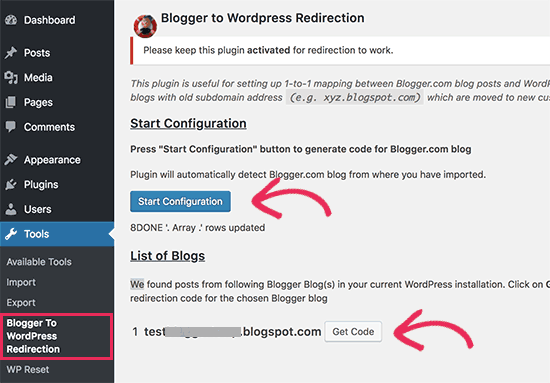
Das Plugin erkennt nun die URL Ihres Blogger-Blogs und zeigt Ihnen die Option an, einen Umleitungscode zu erhalten. Klicken Sie auf die Schaltfläche „Code abrufen“ neben Ihrer Blogger-URL.
Es wird nun ein Codeschnipsel generiert, den Sie benötigen, um Benutzer von Ihrem alten Blogger-Blog auf Ihre neue WordPress-Website umzuleiten.
Als Nächstes müssen Sie sich in Ihrem Blogger-Dashboard anmelden und die Seite „Themen“ aufrufen. Klicken Sie auf den Dropdown-Pfeil auf der Schaltfläche „Anpassen“ neben Ihrem Thema, und wählen Sie dann die Option „HTML bearbeiten“.
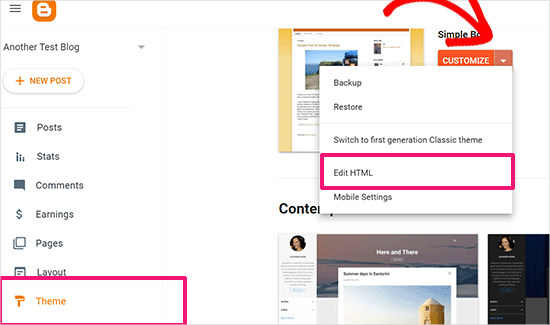
Blogger zeigt nun den benutzerdefinierten HTML-Code für Ihre Themenvorlage an. Wenn Sie Anpassungen an Ihrem Blogger-Theme vorgenommen haben, sollten Sie den Code kopieren und auf Ihrem Computer als Backup speichern.
Andernfalls können Sie einfach alles löschen. Kopieren Sie anschließend den vom Plugin angezeigten Code auf Ihrer WordPress-Website und fügen Sie ihn in den Editor Ihres Blogger-Themas ein.
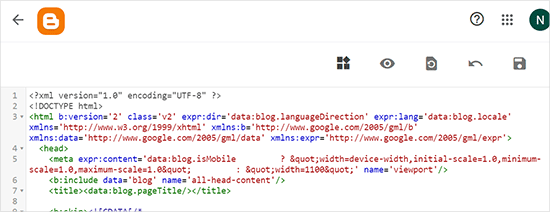
Vergessen Sie nicht, auf die Schaltfläche „Thema speichern“ zu klicken, um Ihre Änderungen zu speichern.
Als Nächstes müssen wir Umleitungen für mobile Benutzer einrichten.
Gehen Sie im Dashboard Ihres Blogger-Blogs zurück zur Seite „Themen“. Diesmal müssen Sie auf die Zahnrad-Schaltfläche unterhalb der mobilen Vorschau Ihres Blogs klicken.
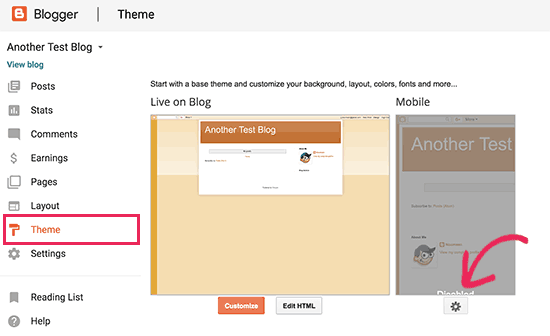
Daraufhin wird ein Popup-Fenster angezeigt, in dem Sie die Option „Nein. Desktop-Thema auf mobilen Geräten anzeigen“ auswählen müssen.
Klicken Sie dann auf die Schaltfläche „Speichern“.
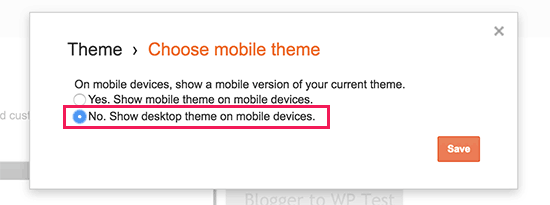
Das war’s. Ihr Blogger-Blog leitet nun alle Besucher Ihres Blogs auf Ihr neues WordPress-Blog um.
Alternativ können Sie auch All in One SEO (AIOSEO) verwenden, um Beiträge und Seiten von Blogger zu WordPress umzuleiten. Das Plugin bietet eine leistungsstarke Funktion für den Weiterleitungsmanager, mit der Sie vollständige Weiterleitungen zu Ihrer neuen Website einrichten können.
Außerdem können Sie die Verfolgung von 404-Fehlern aktivieren und alle defekten Links aufspüren, die bei der Umstellung Ihrer Website auf WordPress auftreten können. Dadurch wird die Benutzerfreundlichkeit verbessert, und Sie verlieren keine Keyword-Rankings.
Schritt 5: Verschieben anderer Inhalte von Blogger zu WordPress
In diesem Schritt werden wir die restlichen Inhalte aus dem alten Blog auf Blogger in Ihren neuen WordPress-Blog verschieben. Dies kann je nach den Einstellungen/Inhalten Ihres Blogs etwas manuelle Arbeit erfordern.
1. Verschieben von Seiten von Blogger zu WordPress
Das Blogger-Import-Tool von WordPress importiert nur Blogger-Beiträge und ignoriert Seiten.
Um Ihre Seiten in WordPress zu übertragen, müssen Sie jede Seite in Ihrem Blogger-Blog bearbeiten, ihren Inhalt kopieren und dann manuell eine Seite in WordPress erstellen.
Um mehr über Seiten zu erfahren, lesen Sie unseren Artikel über den Unterschied zwischen Posts und Seiten in WordPress.
Nun werden Sie auf ein weiteres Problem stoßen. Die Blogger-Seiten haben URLs, die wie folgt aussehen:
http://example.blogspot.com/p/about-us.html
Die URL Ihrer WordPress-Seite sieht dann so aus:
http://example.com/about-us
Um dies zu beheben, müssen Sie das All in One SEO (AIOSEO) Plugin verwenden. Eine Anleitung dazu finden Sie in unserem Leitfaden für Einsteiger zum Erstellen von Weiterleitungen in WordPress.
2. Widgets
Wie Blogger verwenden auch einige WordPress-Themes Widgets, um Inhalte in die Seitenleiste Ihres Blogs einzufügen.
Um Widgets hinzuzufügen, müssen Sie die Seite Erscheinungsbild “ Widgets in Ihrem WordPress-Dashboard aufrufen und Widgets einfach per Drag & Drop in die Seitenleisten ziehen. Ausführliche Anweisungen finden Sie in unserem Leitfaden zum Hinzufügen und Verwenden von Widgets in WordPress.
Wenn Sie ein bestimmtes Widget suchen, das nicht standardmäßig in WordPress enthalten ist, dann benötigen Sie wahrscheinlich ein WordPress-Plugin. Sie können WPBeginners beste WordPress-Plugin-Kategorie durchsuchen, um die gewünschte Funktionalität zu finden.
3. RSS-Feeds
Suchmaschinen und Nutzer, die Ihre Blog-Beiträge über RSS-Feeds abonnieren, können Ihr Blog weiterhin finden. Sie werden jedoch keine neuen Inhalte erhalten.
Um dies zu beheben, besuchen Sie die Seite Einstellungen in Ihrem Blogger-Konto. Scrollen Sie dann nach unten zum Abschnitt „Site-Feed“ und klicken Sie auf „Post-Feed-Redirect-URL“.
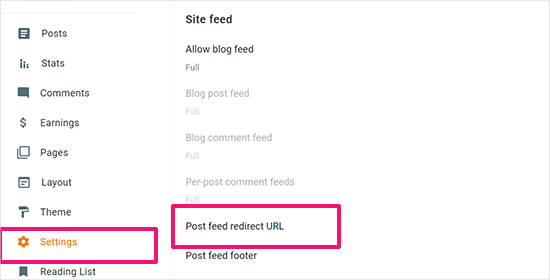
Daraufhin wird ein Popup-Fenster angezeigt, in das Sie die URL des RSS-Feeds Ihrer WordPress-Website eingeben müssen.
Die URL Ihres WordPress-Feeds sieht dann so aus:
http://example.com/feed
Vergessen Sie nicht, example.com durch Ihren eigenen Domänennamen zu ersetzen.
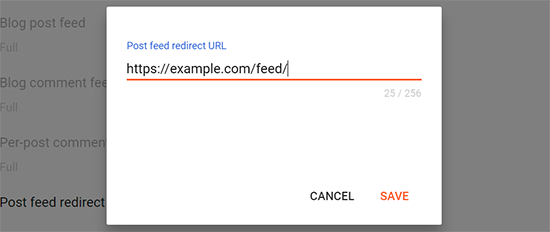
Klicken Sie auf die Schaltfläche „Speichern“, um die URL hinzuzufügen und Ihre Einstellungen zu speichern.
Schritt 6. Was Sie nach der Migration von Blogger zu WordPress tun sollten
Nachdem Sie Ihren Blogger-Blog nun erfolgreich nach WordPress verschoben haben, wollen wir uns ansehen, was Sie noch tun können, um Ihren Blog zu verbessern.
Wir haben eine Checkliste mit den wichtigsten Dingen erstellt, die Sie nach der Installation von WordPress erledigen müssen.
WordPress ist recht einfach zu bedienen. Dennoch werden Sie gelegentlich neue Dinge entdecken, bei denen Sie vielleicht Hilfe benötigen. An dieser Stelle kommt WPBeginner ins Spiel.
WPBeginner ist die größte kostenlose WordPress-Ressourcen-Website der Welt. Wir veröffentlichen regelmäßig Tutorials und Anleitungen, die speziell für Blogger und kleine Unternehmen geschrieben wurden.
Hier sind einige der nützlichen Ressourcen, die Sie auf WPBeginner finden werden (alle sind kostenlos):
- WPBeginner Blog – Der zentrale Ort für alle unsere WordPress-Tutorials und -Anleitungen.
- WPBeginner Dictionary – Unser WordPress-Glossar ist der beste Ort, um sich mit dem WordPress-Jargon vertraut zu machen
- WPBeginner Videos – Neue WordPress-Nutzer können mit diesen Schritt-für-Schritt-Videos beginnen, WordPress zu beherrschen.
- WPBeginner auf YouTube – Brauchen Sie mehr Videoanleitungen? Abonnieren Sie unseren YouTube-Kanal mit mehr als 291.000 Abonnenten und über 50 Millionen Aufrufen.
- WPBeginner Blueprint – Sehen Sie sich die Plugins, Tools und Dienstleistungen an, die wir auf WPBeginner verwenden.
- WPBeginner Deals – Exklusive Rabatte auf WordPress Produkte und Dienstleistungen für WPBeginner Nutzer.
Wir hoffen, dass dieser Artikel Ihnen geholfen hat, von Blogger zu WordPress zu wechseln, ohne Ihre Google-Suchergebnisse zu beeinträchtigen. Vielleicht interessiert Sie auch unser Leitfaden, welchen WordPress-Plan Sie verwenden sollten, oder die häufigsten WordPress-Mythen, die entlarvt wurden.
Wenn Ihnen dieser Artikel gefallen hat, dann abonnieren Sie bitte unseren YouTube-Kanal für WordPress-Videotutorials. Sie können uns auch auf Twitter und Facebook finden.





Ger
Hi!
Really nice tutorial! Plus I’m already subscribed to your newsletter!
I did a migration in local just to test how my blog would look like and what issues I will face on the migration. One that I encountered is that all my internal links written on the posts are broken. My links on Blogger look like: example.com/2023/12/.html and the WP look like this: example.com/2023/12/21/.
Do you know how I can prevent this behaviour or fix the issue after the migration?
Thank you very much!
WPBeginner Support
You would want to use the permalink step in this article to fix your permalink issues.
Admin
Ger
Thanks for the quick answer!
I think you didn’t understand my question, probably because of my poor explanation.
I already used the permalink and it is working fine for changing the urls of the posts, BUT in this case I mean the internal links written inside the post content are linking to the wrong urls.
I already managed to fix it. Before running the blogger importer plugin you must adapt the permalinks to Blogger structure, not afterwards. This way al the internal links written on the post’s content will be correct.
Best,
Peter Iriogbe
Thanks for the post. I want to ask; after the migration, will my blog content need to be indexed again by search engines or everything will still be intact with search engines?
WPBeginner Support
The redirects will keep the pages indexed so everything will still be intact from their point of view.
Admin
EMMANUEL AMADI
I did the whole process some years ago and it worked. I recently noticed my traffic on wordpress doping and checked to notice that blogger posts now only redirect to my wordpress homepage. I ran the Blogger to WordPress Redirect Plugin Start Configuration again, which gave me a code snipet to paste on my blogger theme HTML. Sadly this time, the blogger blog theme refused to save the code snipet and the entire redirection no longer works. Please what do I do to restore the entire redirect setup…?
WPBeginner Support
If it is not saving on Blogger then you would need to check with Blogger’s support to have it save properly.
Admin
Yasir Siddiqui
I had face same issue but did resolve smoothly.
You need to switch by default theme then paste this code. it will work fine.
shivraj
I have a blog on blogpot.com.
My blogger domain is similar to mydomain.com.
I want to move this domain to WordPress hosting. I also want all of the existing URL redirections to WordPress to use the same domain URLs. I am not using the URL of the blogspot domain. Can you help me ?
WPBeginner Support
If we understand what you are wanting correctly then our article above does show how to do what you are wanting.
Admin
Rambabu
Thank you for your detailed material. I received great support from this blog for the second time.
WPBeginner Support
Glad you found our guide helpful!
Admin
Noah oliver
Hey I completely migrated my blogger site to WordPress but I have posts and pages which is indexed in Google I will create a redirection manually all things work perfectly but my homepage is still open in Blogger please help me
WPBeginner Support
If we’re understanding the issue correctly, you would want to ensure your domain name is pointing toward your hosting to ensure that your site is redirecting to your new WordPress site.
Admin
Clem
Thank you so much for that !
WPBeginner Support
You’re welcome!
Admin
Ashikur Rahman
in blogger i have always used my custom domain. so i Don’t have to worry about blogger redirection.
but my question is how can i make sure that my posts redirect to new wp permalink? cause blogger have /year/month/permalink.html while i wants to use /post-name permalink structure.
WPBeginner Support
The redirection steps from our guide should cover setting up those redirects
Admin
Lem Enrile
Thank you so much, WPBeginner, for this detailed tutorial.
I’ve been searching and experimenting for half a day on how to redirect my free Blogger website into a recently purchased domain (with WordPress as platform).
I’ve watched and read countless blogs and Youtube tutorials. But none explained how to redirect „each“ Blogger post to its equivalent new domain URL. I’m glad I found this.
The only problem I encountered is that the generated code from your plugin doesn’t seem to work with Blogger websites that have „customized“ themes.
Even if I deleted all the existing code to paste your plugin’s generated code, it said, „Update Failed.“
I thought that my Blogger website’s „customized theme“ prevented me from „saving“ the generated code.
So I changed my Blogger theme to one of Blogger’s „default“ theme templates, specifically the Dynamic Classic Theme.
I then pasted the generated code from your plugin, then it worked!
WPBeginner Support
Thank you for sharing this for anyone who may be having this issue!
Admin
Mayank Parmar
Hi, wpbeginner support
I’m facing the redirection issue. I followed the all above steps even the step 4 but when i open old urls they won’t redirect. And shows ‚your connection is not private‘.
Please provide me solution.
WPBeginner Support
There is normally more to that error message but you would want to ensure your site is using HTTPS for the most common reason.
Admin
Jim Tolles
Hi! Thanks for the useful content, although I have some questions. I’m not understanding why you would put any code on the old blogger site, which I will take down once the migration is complete. Shouldn’t the live site on WordPress be doing all the redirection?
Additionally, this post needs to be updated as some of the Blogger regions that are mentioned are no longer in the Blogger console.
WPBeginner Support
It is mainly for if users have links to the version of your site with Blogger’s URL instead of your custom domain as you are not allowed to transfer a subdomain to a new host.
We’ll be sure to update our Blogger section the next time we update our article
Admin
Jim Tolles
Gotcha. Yes. I have a custom domain. I’m trying to figure out how to make sure to get everything pointed in the right direction.
WPBeginner Support
Understood, then this will ensure if anyone visits your Blogger site it will be redirected to the new site with the correct URL
P Mohapatra
I was earlier using blogger and now I have sifted to wordpress. But the faviocon of blogger is still showing in search console. How to solve this.
WPBeginner Support
You would want to either ask the search engine to recrawl your site, or you would need to wait for the search engine to clear its cache and update your favicon.
Admin
Amit Singh
This was very helpful, I have successfully redirect my blogger links to wordpress. But when I was using blogger, I used to create custom permalink in it and then after changing from blogger to wordpress, the whole link changed. And also many pages of the new website got indexed in Google. Means, both blogger and new websites links are indexed on Google with same contents. This create many issues like content duplicate and page duplicate. How to solve them.
WPBeginner Support
You would want to be sure you follow our steps to set up redirects and that would point your old content to the new content which will prevent your duplicate content issues.
Admin
Emily Cowe
Hey! This was a great tutorial, but I have 1 question – is it required to change the permalink structure on WordPress to redirect the links? I am migrating from Blogger to an existing WordPress site with existing articles, so I don’t really want to change the current permalink structure if I don’t have to. Thanks
Sunny
I migrated my website 2 years ago. Can I deactivate the plugins (Blogger to wp and All in one wp migration) now?
Isack Godlaison
I have done everything as you guide and able to move my site to wordpress successful. The only issue i face is the post redirections works perfect on desktop but doesn’t work on mobile, can you help me fix this? Thanks
Chandu
I’ve almost 1300 posts in by Blogger blog and when I try to import all my posts to my WordPress site by following all the given instructions, Happens nothing. not a single post getting imported. Can any one suggest me a solution.
WPBeginner Support
You would first want to check in your media library to see if the images are being imported and if they are you would want to run the import again as it is likely timing out and when you run the import again it should skip what has already been imported.
Admin
Kishan sarvaiya
Thank you very much for this detailed and doubt solving guide.
Now i habe just 3 questions.
1. Can i delete the „blogger importer“ pkugin after importing content?
2. Can i delete „blogger to wordpress“ plugin after pasting the code in blogger provided by this plugin.
3. After migrating to wordpress, should we delete the blogger blog from blogger. Com? (i jave custom domain on blogger).
Thank you very very much…
WPBeginner Support
The plugin is to help with redirects from the blogspot URL, if you disable the plugin then those redirects can break. Your other redirects should be fine with how the plugin is currently set up.
Admin
dema
Great Post, well done BUT
I have problem. Tried your script but when I go to an old posting I just get redirected to my first page, not to the post.
WPBeginner Support
You would want to ensure you followed all steps under ’step 4 Setup Redirects from Blogger to WordPress‘ for your redirects to work properly.
Admin
Hope Linus
Please i moved from blogger to wordpress but the links are shared while i was on blogger are not opening, they are showing error 404.
Please what will i do
WPBeginner Support
You would want to ensure you set up redirects under step 4
Admin
Aman Pathak
Hey Editorial Staff
In this post you told to change WordPress permalink structure to near blogger permalink structure.
But it doesn’t require for seo because blogger to WordPress redirect plugin will redirect old post url(permalink) to new post url(any permalink structure)
I have also tried this and i want that you guys should update this post
WPBeginner Support
Thank you for letting us know about that update to the redirection plugin.
Admin
Favour
Please when migrating to WordPress, will the blogger theme also be moved. Or I will have to get a new WordPress theme?
WPBeginner Support
You would need a new theme on the WordPress site.
Admin
Tanaaz
Hi! I’ve already migrated from Blogger to WordPress thanks to your tutorial. But I’m planning to apply for Adsense, so if I delete or unpublish my old blogger blog, does that mean all the redirects will stop and whatever content has been imported will also be deleted? Even though it was uploaded externally.
Just wondering, would be great if you could help me out with this! Thank you!
WPBeginner Support
You would want to check with the plugin’s support for questions like this. You shouldn’t lose content on the WordPress.org site but there may be trouble with redirects.
Admin
Fabian George
Thanks for this article. My blog is hosted by blogger and a custom domain pointing at it from Goddady for almost 2yrs and two months. Is it possible to use same domain name or I should fresh one from bluehost?
Please I need help to on this urgent
WPBeginner Support
Yes, you can use the same domain.
Admin
Emily Sego
Can I delete the Blogger importer plugin from my WordPress website? The plugin hasn’t been updated in 4 years, and I’m wondering if it’s interfering with the functionality of my other plugins…..
WPBeginner Support
You only need to have the importer during the import of files. After that, you can remove the plugin. The plugin should not be affecting your site as it should only run during the import process.
Admin
Rehbar ansari
If I will take my website from Blogger to WordPress, then I have to add it back to Google Search Console.
WPBeginner Support
You would want to re-add your meta tag for search console to your site to ensure it stays verified.
Admin
Siddiq
Hi. Followed all these steps and successfully migrated to wordpress from blogger but there is an issue of 404 error.
If I clicked on some of my page from google search results or elsewhere it results to 404 error.
Please what can I do to solve this. Thank you
WPBeginner Support
You would want to ensure you set up your redirects properly for the search results but for the 404 on the site itself, you would want to take a look at our guide below:
https://www.wpbeginner.com/wp-tutorials/how-to-fix-wordpress-posts-returning-404-error/
Admin
Oluwafemi
I have few post on my blogspot (I started 6 months ago) and I intends migrating to WordPress, Should I just open a WordPress acct and copy and paste my articles into it. Or should I follow up with the process you put up there?.
WPBeginner Support
That would depend on your personal preference more than what would be best.
Admin
naveen
I’ve tried to upload my XML file several times and it never works. I’m always sent to a screen that says ‘Import Blogger’ with a submit button and submit button only..No import author or any other messages., and then
‘All done. Have fun!
Remember to update the passwords and roles of imported users.’
WPBeginner Support
You may want to try downloading the file again in case it is an error with the original file you’ve downloaded.
Admin
Payal Rathore
hey! thankyou for sharing this. I have successfully migrated my blog but what after that how to link google search console to my new domain.
WPBeginner Support
For connecting your WordPress site to Google’s search console you would want to take a look at our article below:
https://www.wpbeginner.com/beginners-guide/how-to-add-your-wordpress-site-to-google-webmaster-tools/
Admin
Kamaljeet Kaur
I successfully migrated from blogger to WordPress. everything is working fine, But for some posts, the comment section is not visible( display comment option is already enabled) but in other posts comment section is visible. I already did lots of research on it but nothing is working.
WPBeginner Support
You would want to ensure on those specific posts that you haven’t disabled comments.
Admin
Elochi
Thank you so much for this wonderful article, it was very helpful and I have successfully moved my blog to WordPress.
Thanks for all the information you provided here.
Do have a nice day buddy.
WPBeginner Support
Glad our guide was helpful
Admin
Karen Ann
Hi, Thank you so much for all this helpful information. I have a simple question.
So if you don’t have any Google standing yet nor any subscribers would you then just copy and paste all of your blog posts over and skip the other part or is it best to complete the whole procedure as described? Also, when I was watching the video I didn’t see any point where the person chose their theme. Don’t you need to do that before you transfer posts over? Thank you!
WPBeginner Support
If you are not worried about your site or your current ranking then you certainly can copy your content over if you wanted rather than following our guide.
There is a default theme installed that you can change, you don’t need to select your theme before transferring but it can be helpful.
Admin
Rakesh Verma
Thank for this great information. I have successfully migrated my blog from blogger to WordPress.
WPBeginner Support
Glad our guide was helpful
Admin
Kamaljeet Kaur
Hii, I successfully migrated from blogger to WordPress. I have 117 posts that i imported into WordPress. I m getting error 404 on all post. Please help me how can i resolve this issue.
WPBeginner Support
For that error, we would recommend taking a look at our guide below:
https://www.wpbeginner.com/wp-tutorials/how-to-fix-wordpress-posts-returning-404-error/
Admin
Kamaljeet Kaur
I am using custom domain on blogger. Do i have to firstly redirct back to blogspot.com for migration. And Do i have to register again for google analytics and search console..
WPBeginner Support
You do not need to point your site back to the blogspot URL, you would want to move the required codes over but you do not need to register again.
Admin
Nicole
I am successfully transfered to WordPress from Blogger thanks to your instructions! I do have a question though – do I tell Google to no longer track my old blog posts over at all Blogger (via their privacy settings)? (That way that the old blogger blog doesn’t come up in the search engine?)
WPBeginner Support
The redirects you set up would handle that for you
Admin
venkat
This is what I’ve been met with when trying to import my Blogger blog …
– tools > import > Blogger Run Importer > Choose File > Upload file and import
– it loads at the bottom of my screen by % then once it’s complete all it displays is a button that says “Submit”. No other text.
– then all it says is “All done. Have fun! Remember to update the passwords and roles of imported users.” and nothing has changed. I can’t find my blog posts anywhere.
WPBeginner Support
You may want to try recreating the backup file to ensure there weren’t any issues with the creation of the file from Blogger’s end
Admin
swe
Hi! This is an amazing one and a very good problem solver. Thanks in advance. And I have a question…if I transfer from blogger to WordPress…will I lose my total views (for eg. xxK views) from my blog that I got only from blogger?
WPBeginner Support
It would depend on where you mean. If you mean on your site’s analytics then you would keep that.
Admin
Navas PT
Import Blogger:
My XML file size is 48 mb, but here in my Maximum size: 32 MB to upload in wordpress? How to increase? we need to change the hosting plan ?
WPBeginner Support
For changing your upload limit, you would want to take a look and follow our guide below:
https://www.wpbeginner.com/wp-tutorials/how-to-increase-the-maximum-file-upload-size-in-wordpress/
Admin
Ahmed Parbes
Thanks for your post. But i am new on wp. I used blogger for a long time and i published 399 articles on it. When i want to import all blogger posts on wordpress. Its said that Sorry, there has been an error. File is empty. Please upload something more substantial.
But i have a right file and upload it.
Please give me a idea that how can i rid from it?
WPBeginner Support
It is hard to say, if the file is correct, you would want to try increasing the file upload size. We have a guide on how to do this below:
https://www.wpbeginner.com/wp-tutorials/how-to-increase-the-maximum-file-upload-size-in-wordpress/
Admin
revti
hello, thanks for the information. but tell me that do i need to buy a web hosting for wordpress …i have already buyed a domain and currently working on blogger where blogger provides free webhosting .
WPBeginner Support
Yes, you would need hosting for your site.
Admin
Jen Allen
Once I customize my permalinks, I get this message: Remove write access on web.config file now! What do I need to do to the web.config file to prevent over write?
WPBeginner Support
That is normally a permissions error. You can try resaving your permalinks, otherwise, you would want to reach out to your hosting provider for assistance.
Admin
Paul
Pls I would prefer to not create the same permalink structure with migration, as I don’t want dates in the url.
Is there another way to deal with the concern regarding 404’s, since I don’t want the same urls with dates?. I need only: mysite.com/post-link-here
WPBeginner Support
You would need to manually create the redirects for each post to do what it sounds like you’re wanting.
Admin
Abragam M
while importing the blogger content of file size 31MB, after uploading 100%, it shows an error, There has been a critical error on your website. Please check your site admin email inbox for instructions.“
WPBeginner Support
For that error, you would want to take a look at our guide below:
https://www.wpbeginner.com/wp-tutorials/how-to-fix-the-wordpress-white-screen-of-death/
Admin
Blogone
Is there an issue with the functions.php code. Using the WordPress editor, it won’t let me save citing issues in the code.
WPBeginner Support
If the error is WordPress can’t safely test the code then you can use your host’s file manager or FTP to get around that. We have a guide on FTP below and the error is WordPress attempting to warn users to be cautious about adding code to files through the WordPress editor.
https://www.wpbeginner.com/beginners-guide/how-to-use-ftp-to-upload-files-to-wordpress-for-beginners/
Admin
TutorialsMate
I am thinking to move my blogger site on WordPress. But I have a question on my mind. Assume, I followed the entire tutorial and set up everything as given. In this way, we set our link as „www.domain.com/year/month/abc“. if I set this structure on WordPress, will my future posts will follow the same structure or I can manage future post URL in this way- „www.domain.com/abc“ ?
WPBeginner Support
If you change the url structure to remove the date you would manually need to create redirects for all of your current posts sadly.
Admin
Shivani Pahadiya
Thank you for this.
Then overall can I say that it will be all okay in future if I am starting a blog on blogger and I will not face any issues further in terms of transfer everything from blogger to WordPress?
WPBeginner Support
It would depend on what you add and if Blogger changes what is possible to export sadly.
Admin
RAMEEZ REZA
I’m a beginner in blogging platform. Till now my website have been seen yet approx 2k, and now after knowledge of some bedrock of Blogger I want to migrate my Blog into WordPress. My query is that can I loose all the 2k views data while I migrate to WordPress?
Please help me out.
WPBeginner Support
It would depend on what you mean, you shouldn’t have to worry about your previous views and as long as you set up the redirect you shouldn’t lose visitors.
Admin
Kartik Satija
Excellent article guys. Followed all the easy step by step instructions and was able to easily switch from Blogger to WordPress. Have also been able to setup redirects thanks to you guys. Really appreciate the detailed and well written article. More power to you guys !
Thanks again.
WPBeginner Support
You’re welcome, glad our guide was helpful
Admin